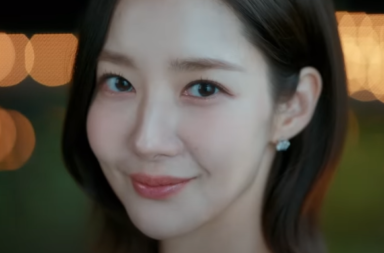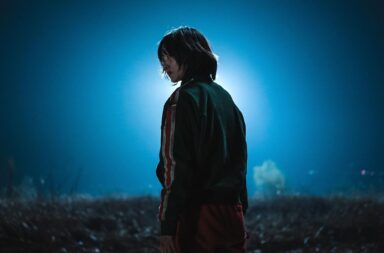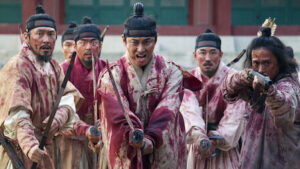
South Korea’s recent flourishing zombie horror genre has tackled many societal issues in a relatively short time frame. As cyphers for everything from racism to consumerism, class war to ‘the other’, zombies are consistently a rich symbol for Korea to mine. A monstrous disease enforcing isolation in #Alive, and a brutal threat turning normal people against one another in Dark Hole and Train to Busan, the Korean film and TV industry has already achieved a lot with the undead. But perhaps no show or film has delved as much into the complexities that violent, running corpses can present as Netflix’s Kingdom. Set in the Joseon dynasty, a world away from most modern-set zombie stories, the show reveals the cruelty of the ruling classes and the brutality that ensues from their lust for power.
Kingdom is as much about politics as it is about blood and horror, a fact that has only been amplified by the release of a stand-alone spin-off, Kingdom: Ashin of the North. An origin story detailing exactly how a horrific plague of monsters was unleashed in Joseon-era Korea, Ashin is a tale of discrimination and revenge. As an addendum to the first two series of Kingdom, it emphasises how it is the political machinations of elites that have not only allowed zombies to flourish, but ultimately caused their introduction into ancient Korea.
This review contains spoilers.
Whilst the main Kingdom series focuses more on high-ranking characters–the regent Queen, the Crown Prince, the evil Haewon Cho clan–the spin-off focuses on the titular Ashin, a lowly girl from a border village (played formidably by Jun Ji-hyun). The position of this village is integral: the inhabitants are technically Jurchen people, and not Joseon citizens. This means that they are outsiders, though Ashin’s father has remained loyal to Joseon all his life. When fifteen Jurchen men end up dead in a pit in the mysterious forest of Pyesa-gun, tensions with Joseon’s neighbours reach dangerous heights, only quelled when a Joseon commander frames Ashin’s village as responsible, leading to brutal massacre.

The drama, as in the first two series of Kingdom, does not shy away from showing the horror of this massacre in violent detail, driving home the very real impact of Machiavellian political manoeuvres on the lower classes who always end up suffering. Arrows are shot, heads are lost, axes are thrown.
Without a monster in sight, Ashin is able to highlight the brutality already existing in its society. The emotional undercurrent of this pours out when young Ashin, spared by being absent foraging in the forest, weeps at the sight of her family strung up, hanged in the ruins of her village. It’s a moment that is powerfully sad and allows her character a pathos that is more indirectly implied in the main series.
That is not to say that Kingdom itself is not poignant, but more that its own focus lies on demonstrating the mass effects of higher-class callousness. Where Ashin shows us one villager’s pain, Kingdom shows the mass hysteria and suffering of entire villages through its masterful set pieces. For example, in the show’s very first episode, the climax sees a village, who had unwittingly been eating infected human meat, die en masse, returning as snarling monsters to devour the only surviving nurse.
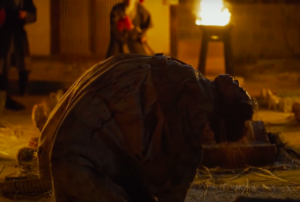
Beginning with the nurse realising that all around her are dead, the scene slowly reveals what has happened to the bodies as first one writhes, then another, then another. The final shot, a mountain of zombies feasting on the nurse, is no less powerful then what Ashin achieves. This monstrous scene is born of the scourge of hunger, one of the many social evils that plague the Kingdom universe.
The power of the cinematography of Kingdom cannot go unmentioned, with the framing and detail in many of the show’s most thrilling sequences adding to the scale of what is happening. Often the editing is cinematic, with wide vistas encompassing sweeping mountain ranges, grand palaces and raging hordes of the undead. Whilst the show is often dark due to the night time setting awakening the zombies, the rich colourisation provided by basic elements like fire and blood—and boy there is no shortage of that–prevent this from becoming murky too often.
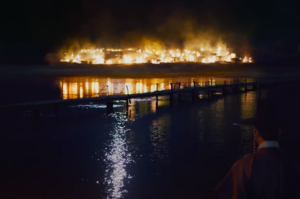
Ashin brings in more earthy tones than Kingdom, with the browns of the earth and green of forest standing out most. Across both shows the use of colour feels elemental, echoing a sense that the issues handled in the show are natural. We are dealing with human nature here, and that nature is cruel.
Within the story of Ashin, the Joseon officials that the main character encounters coldly implicate her village without remorse, much as the potential enemy forces (the Pajeowi Jurchen) similarly cruelly imprison her own father as a traitor. When adult Ashin, who has spent all her life in the forests, and is mighty handy with a bow and arrow, discovers this, her own brutality is total. Whilst this is, at best, morally ambiguous to reason with on the part of the audience, her anger and sense of injustice is made clear.
Unleashing the plant that creates these zombified creatures on the soldiers she has lived with (but have never treated her well), she watches coldly from the rooftop as they turn. It’s an intriguing switch from the coldness in the main Kingdom series, where we normally see this detachment from the regent Queen (a gleeful Kim Hye-jun), or the soldiers in her command. Witnessing it from this different perspective, a low-born protagonist who is specifically an outsider, it reframes all the events of the main series with a question mark. Do the people of Joseon deserve this plague? Is this how justice works on this scale?
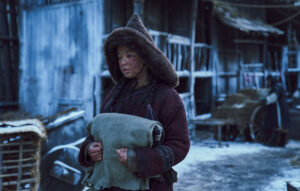
This outsider factor is worth noting in the political context of Ashin and its position in the wider Kingdom universe. The significance of Ashin’s town not being part of Joseon is key to why it becomes a scapegoat. It is not a part of the country- loyal as it has been- and thus it is expendable. This is highlighted through the villagers’ visual presentation as being distinct from that of Joseon commanders we meet: their clothing is made from thicker, earthier materials, and differs in shape from the traditional hanboks we’ve largely seen in Kingdom. In this stand-alone episode, it is made starkly clear that Ashin’s people suffered because of their perceived lowliness, and that perceived lowliness came from their identity.
The potency of these political and social observations are what separate the Kingdom franchise from so many other zombie narratives. As mentioned above, politics is key to the portrayal of the zombie, but in Kingdom, they become an actual weapon of the elites. For instance, in season 2, it is revealed that the resurrection plant (that creates the monsters) was used by Lord Ahn on dead Joseon soldiers, so that they could fight off 30,000 Japanese soldiers. This is a quite literal weaponization of the masses, and it is clear from the carnage that ensues in villages and cities across the country that the consequences of this weaponization are dire.

Aside from deliberate abuse of the lower classes, Kingdom also demonstrates cuttingly how the mismanagement and carelessness of the elites leads to the suffering of the poor. As well as these Joseon soldiers, the resurrection plant was used on the country’s ailing King in an effort to restore him to health. It does not go well. When he becomes zombified, it is courtiers who are fed to him, and the evil regent Queen who takes over control of the palace, setting more horrific events in motion that topple the country and its people into hell. The desperation of the palace to keep their king in power directly leads to chaos: the metaphor of corruption here is clear.
Ashin adds a clever layer to this particular moment of corruption, making Ashin herself the person who gave it to the King’s physician. As the ultimate source of the monstrous plague in Joseon, this is a satisfying origin story, tying in a pure, bitter and cold revenge into the deeper layers of the narrative. In a genre where origins can make or break the horror (as in the recent Dark Hole), Kingdom works cleverly to ensure that the origin reveal adds to the complexities of the story, rather than oversimplifying them.
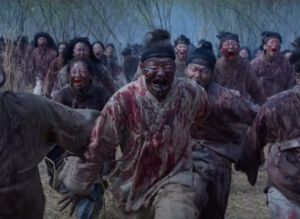
Ultimately, both Kingdom and Ashin: Kingdom of the North use the historical setting of warring factions and power-hungry ruling classes to tell savage tales of human cruelty and revenge. Though this is a period drama, through the epic cinematography and clever narrative we are given a story that is timeless. These monsters may be from a time before guns, consumerism or global pandemics, but the story they embody is just as modern as ancient. The Kingdom universe deftly explores why such chaos can ensue, with Ashin focussing in on the pain that mass suffering causes to individuals, and the cycle of violence that can then spill forth.

